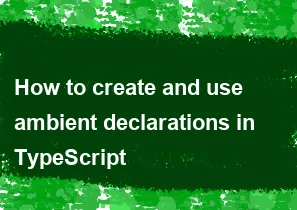How to create and use ambient declarations in TypeScript

In TypeScript, ambient declarations are used to tell the compiler about the shape of external code that is not written in TypeScript. They allow you to use existing JavaScript libraries or code in your TypeScript projects without causing type errors. Ambient declarations are typically defined in .d.ts files, which stand for declaration files.
Here's a step-by-step guide on how to create and use ambient declarations in TypeScript:
1. Create a Declaration File (.d.ts):
Create a new file with a .d.ts extension, for example, myLibrary.d.ts. This file will contain the ambient declarations for the external code.
typescript// myLibrary.d.ts
declare module 'my-library' {
// Declare the types for the external module or library here
// Example: If the library exports a function
export function myFunction(param: string): void;
// Example: If the library has a class
export class MyClass {
constructor(name: string);
sayHello(): void;
}
// Add more declarations as needed
}
In this example, we're declaring a module named 'my-library' and specifying the types for a function (myFunction) and a class (MyClass).
2. Reference the Declaration File:
In your TypeScript code, reference the declaration file using a triple-slash directive at the top of your file.
typescript// myApp.ts
/// <reference path="./myLibrary.d.ts" />
// Now you can use the external module in your TypeScript code
import { myFunction, MyClass } from 'my-library';
// Use the declared types
myFunction('Hello, world!');
const instance = new MyClass('John');
instance.sayHello();
3. Install the Library (if necessary):
If the external library is not already installed, install it using your package manager. For example, if using npm:
bashnpm install my-library
4. Compile TypeScript Code:
Compile your TypeScript code using the TypeScript compiler (tsc).
bashtsc myApp.ts
5. Run the JavaScript Code:
Now you can run the generated JavaScript code (along with the ambient declarations) in your project.
bashnode myApp.js
This way, TypeScript understands the shape of the external library based on the ambient declarations, allowing for type-checking and autocompletion in your editor, while still using the existing JavaScript code.
Note: Depending on the library, you may find existing declaration files on DefinitelyTyped (https://definitelytyped.org/) or in the library's repository. If available, it's often preferable to use those declaration files rather than creating your own.
-
Popular Post
- How to optimize for Google's About This Result feature for local businesses
- How to implement multi-language support in an Express.js application
- How to handle and optimize for changes in mobile search behavior
- How to handle CORS in a Node.js application
- How to use Vue.js with a UI framework (e.g., Vuetify, Element UI)
- How to configure Laravel Telescope for monitoring and profiling API requests
- How to create a command-line tool using the Commander.js library in Node.js
- How to implement code splitting in a React.js application
- How to use the AWS SDK for Node.js to interact with various AWS services
- How to use the Node.js Stream API for efficient data processing
- How to implement a cookie parser middleware in Node.js
- How to implement WebSockets for real-time communication in React
-
Latest Post
- How to implement a dynamic form with dynamic field styling based on user input in Next.js
- How to create a custom hook for handling user interactions with the browser's device motion in Next.js
- How to create a custom hook for handling user interactions with the browser's battery status in Next.js
- How to implement a dynamic form with dynamic field visibility based on user input in Next.js
- How to implement a dynamic form with real-time collaboration features in Next.js
- How to create a custom hook for handling user interactions with the browser's media devices in Next.js
- How to use the useSWRInfinite hook for paginating data with a custom loading indicator in Next.js
- How to create a custom hook for handling user interactions with the browser's network status in Next.js
- How to create a custom hook for handling user interactions with the browser's location in Next.js
- How to implement a dynamic form with multi-language support in Next.js
- How to create a custom hook for handling user interactions with the browser's ambient light sensor in Next.js
- How to use the useHover hook for creating interactive image zoom effects in Next.js